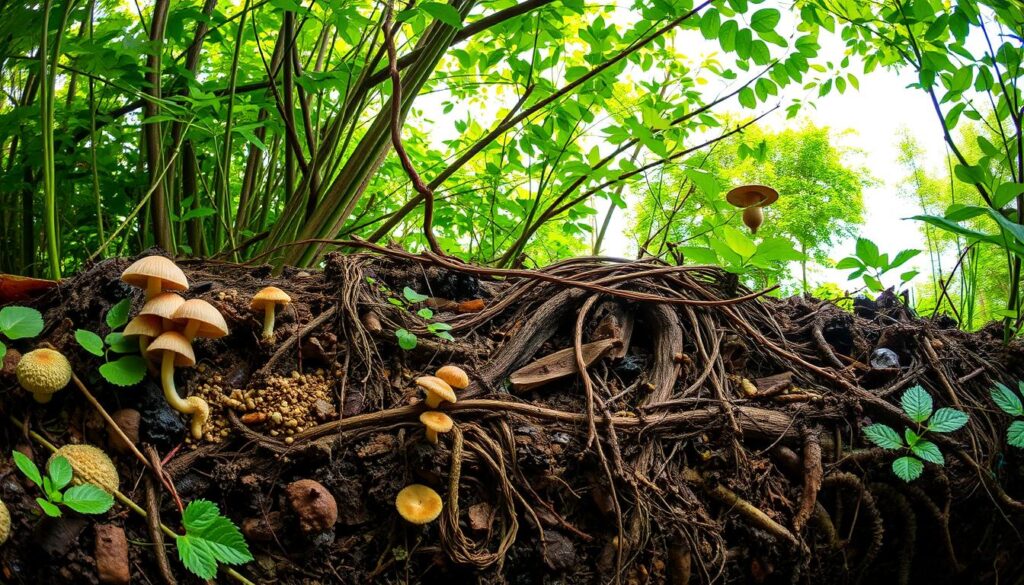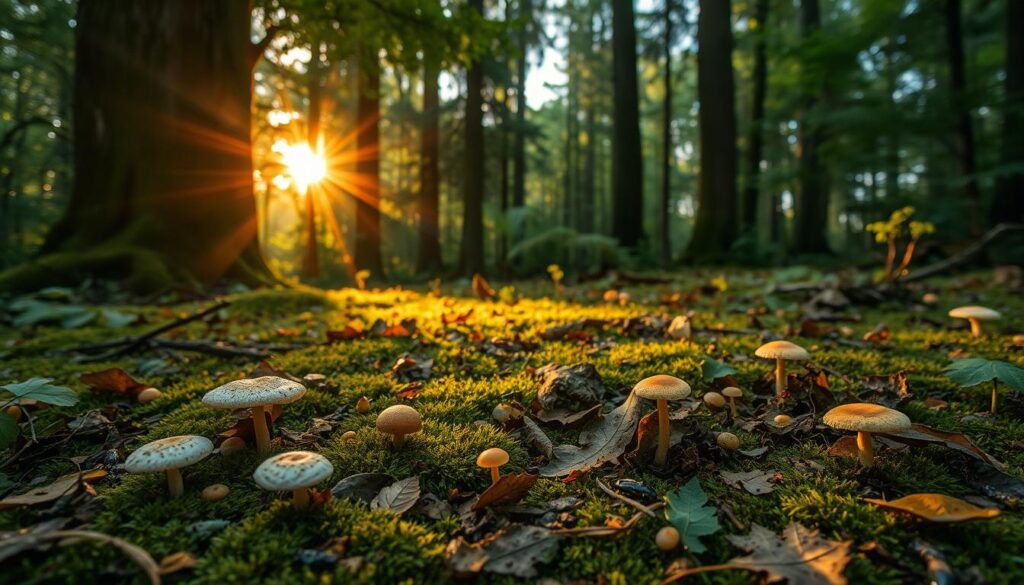Have you ever thought about how some living things survive without making their own food? Heterotrophic nutrition is a unique way for organisms to get what they need from outside. They eat organic compounds to live and grow.
This way of getting nutrients is key for many living things. Unlike plants that make their own food, heterotrophs need to find and eat other organic matter. This is how they get the energy and nutrients they need.
Heterotrophic nutrition is important for all kinds of life, from tiny bacteria to big animals. This guide will show how different creatures get and use nutrients from their surroundings.
Key Takeaways
- Heterotrophs depend on external organic compounds for nutrition
- Food absorption is essential for energy generation
- Diverse organisms utilize different nutritional strategies
- Organic compounds serve as primary energy sources
- Heterotrophic nutrition supports ecosystem interconnectedness
Understanding Heterotrophic Nutrition and Its Significance
Heterotrophic nutrition is key for energy in living things. Unlike plants, heterotrophs can’t make their own food. They need to eat other organisms to survive.

Living beings have many ways to get nutrients. The world of heterotrophs is full of different types. These include consumers and decomposers that are vital for nutrient cycles.
Basic Principles of Food Absorption
Food absorption in heterotrophs involves several key mechanisms:
- Breaking down complex organic compounds
- Extracting essential nutrients
- Converting consumed matter into usable energy
“Every organism’s survival depends on its ability to efficiently process and utilize nutrients.” – Ecological Research Journal
Role in Energy Acquisition
Consumers and decomposers are key in energy transfer in ecosystems. They turn organic matter into energy through metabolic processes. This ensures nutrients keep circulating.
Importance in Ecosystem Balance
Symbiotic relationships between heterotrophs keep ecosystems balanced. Decomposers break down dead matter, recycling nutrients. This supports life processes.
Heterotrophs play a big role in nutrient cycles. They help energy flow sustainably. This keeps life balanced in different habitats.
Types of Heterotrophs in Nature

Heterotrophs are a diverse group of organisms with unique ways to get food. They can’t make their own food and need to eat organic matter from others. Knowing about their different ways of eating helps us understand ecosystems better.
There are many ways heterotrophs get their food:
- Chemoheterotrophic organisms get energy by breaking down chemicals from other living or dead things
- Photoheterotrophic organisms use light for energy but need organic compounds for carbon
- Saprotrophic nutrition means eating decaying organic matter, important for recycling nutrients
- Parasitic nutrition involves living on or inside hosts, getting nutrients directly from them
- Symbiotic nutrition shows mutually beneficial relationships between different species
Each way of eating shows how adaptable heterotrophs are in different places. From tiny bacteria to big, complex organisms, these ways help them survive in various environments.
Examples in the real world show these eating strategies. Fungi that eat dead wood in forests are an example of saprotrophic nutrition. Some bacteria have symbiotic relationships with plant roots, trading nutrients for benefits.
Mechanisms of Organic Matter Consumption
Heterotrophs have clever ways to break down organic matter. They use complex digestive processes to get nutrients from their surroundings. This process turns raw materials into energy and building blocks for their cells.
The journey of organic matter consumption has many important stages. These stages help in efficient nutrient absorption and keeping the organism healthy.
Digestive Processes and Enzyme Activity
Enzymes are key in breaking down complex organic compounds. Different organisms have special enzymes for different tasks:
- Proteins into amino acids
- Carbohydrates into simple sugars
- Lipids into fatty acids
Cellular Transport Systems
Nutrient absorption needs special systems to move molecules across cell membranes. These systems include:
- Active transport
- Passive diffusion
- Facilitated diffusion
Nutrient Absorption Pathways
Heterotrophs use different pathways to get energy from organic matter. The efficiency of these pathways varies among different organisms.
| Organism Type | Primary Absorption Mechanism | Efficiency Rate |
|---|---|---|
| Unicellular Organisms | Direct membrane absorption | 85-95% |
| Multicellular Organisms | Specialized digestive systems | 70-90% |
| Fungi | Extracellular digestion | 75-85% |
Understanding these intricate mechanisms shows how adaptable heterotrophs are in consuming and processing organic matter in different environments.
Comparative Analysis of Autotrophs vs Heterotrophs
The world of nutrition in living things is really interesting. It shows how different life forms get energy and nutrients. This diversity is amazing.
Autotrophs make their own food. Plants and some bacteria do this by using sunlight or chemical reactions. On the other hand, heterotrophs need to eat other living things or organic matter to get their nutrients.
- Autotrophs create their own food through photosynthesis
- Heterotrophs rely on external food sources for energy
- Autotrophic nutrition allows direct energy conversion from sunlight or chemical reactions
Autotrophs and heterotrophs are more than just different ways to eat. Heterotrophs are very good at finding food. They can hunt or live together with other organisms.
| Characteristic | Autotrophs | Heterotrophs |
|---|---|---|
| Food Production | Self-produced | Externally acquired |
| Energy Source | Sunlight/Chemical reactions | Organic compounds from other organisms |
| Examples | Plants, Algae, Some Bacteria | Animals, Fungi, Most Bacteria |
Learning about autotrophs and heterotrophs helps us understand ecosystems better. Autotrophs start food chains, while heterotrophs are key in moving nutrients and energy around.
Ecological Importance of Heterotrophs
Heterotrophs are key to keeping ecosystems in balance. They eat and break down organic matter, helping nutrients flow. This keeps energy and nutrients moving in nature.
Heterotrophs have big effects on ecosystems. Decomposers turn dead plants and animals into nutrients. This lets other living things use these nutrients, keeping the cycle going.
- Consumers help regulate population dynamics
- Decomposers recycle organic materials
- Nutrient cycles depend on heterotrophic activities
Different heterotrophs do different jobs in ecosystems. Bacteria, fungi, and animals all help process organic matter. They keep energy moving and life balanced.
Heterotrophs are the unsung heroes of ecological sustainability, silently maintaining the intricate balance of life on our planet.
Learning about heterotrophs shows us how connected nature is. Their ways of eating and breaking down matter show us the importance of every living thing. They help keep ecosystems healthy and in balance.
Challenges and Adaptations in Heterotrophic Nutrition
Heterotrophs face big challenges in getting food and energy in different places. They must find clever ways to eat organic compounds and live in tough environments.
Different heterotrophs have come up with special ways to deal with these challenges:
- Specialized digestive enzymes for breaking down complex organic matter
- Advanced cellular transport systems for efficient nutrient absorption
- Symbiotic relationships that enhance food acquisition
- Metabolic flexibility for adapting to changing food sources
In extreme places, heterotrophs show amazing strength. For example, deep-sea creatures have bacteria friends to get energy from hot vents. These amazing adaptations show how nature finds new ways to eat.
Some heterotrophs can take nutrients right from their hosts. Others, like carnivorous plants, have traps to catch food when it’s hard to find.
Nature’s creativity in solving nutritional challenges is truly extraordinary.
The way heterotrophs keep evolving to eat organic compounds is amazing. They show how life on Earth can adapt to any situation.
Conclusion
Heterotrophic nutrition is a key part of life’s complex interactions in ecosystems worldwide. From tiny bacteria to big predators, all need to eat organic matter to live. This way, they get the energy and nutrients they need from their surroundings.
This method of eating shows how nature can adapt in amazing ways. It lets many species survive and thrive in different places.
Looking into heterotrophic nutrition, we see a web of survival tactics. Each species has its own way of getting and using nutrients. This shows the wide range of ways life can adapt.
Some eat directly, some break down food, and some work together with others. All these actions help keep ecosystems balanced.
Science keeps finding out more about how organisms get and use nutrients. This helps us understand biodiversity, how energy moves, and the balance of life on Earth. Every heterotrophic organism adds to the story of survival and connection in our world.
Thinking about heterotrophic nutrition, we see the incredible ways life is sustained. From tiny cells to big ecosystems, these eating strategies show life’s strength and creativity. Our exploration of heterotrophic nutrition shows the deep complexity of every living thing’s survival.
FAQ
What exactly is heterotrophic nutrition?
Heterotrophic nutrition means organisms can’t make their own food. They need to eat other living or dead things to get energy and nutrients. This is different from autotrophs, who can make their own food.
What are the main types of heterotrophs?
There are many types of heterotrophs. Some get carbon and energy from organic compounds. Others use light but still need organic compounds. There are also decomposers and parasites that get nutrients from hosts.
How do heterotrophs obtain their energy?
Heterotrophs get energy by eating and digesting food. They break down organic matter with enzymes. Then, they turn it into energy that their cells can use.
What role do heterotrophs play in ecosystems?
Heterotrophs are vital for ecosystem balance. They eat and break down organic matter. This helps recycle nutrients and keeps ecosystems healthy.
What’s the difference between autotrophs and heterotrophs?
Autotrophs make their own food, like plants do with sunlight. Heterotrophs need to eat other organisms to get energy. Autotrophs are producers, while heterotrophs are consumers.
Can you give examples of heterotrophs?
Many examples exist, like animals, fungi, and some bacteria. Even tiny protozoa and big mammals are heterotrophs. Each has its own way of getting and using organic nutrients.
How do heterotrophs adapt to different environments?
Heterotrophs adapt in many ways. They have special digestive systems and can form symbiotic relationships. They also have unique ways to eat and get nutrients from different sources.
What are the primary mechanisms of nutrient absorption in heterotrophs?
Heterotrophs use enzymes and transport systems to absorb nutrients. They break down food with enzymes and use special structures to get nutrients. This helps them survive.
